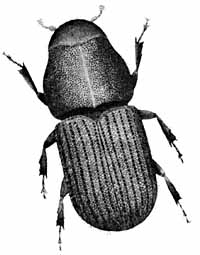Silent killer invades SNRA
By GREG STAHL
Express Staff Writer
 (Picture courtesy U.S. Forest Service)
(Picture courtesy U.S. Forest Service)
A silent killer is working its way through the Salmon River canyon in the
Sawtooth National Recreation Area (SNRA).
Its name is the mountain pine beetle, and it’s attacking the
area’s lodgepole pine trees.
"The beetles always just sort of bounce around," Sawtooth
National Forest timber program manager Jim Rineholt said in an interview Monday.
"They’re always out there. They just move from pocket to pocket, but down in the
canyon, there, they’ve really just blown up."
If all goes as planned this spring, SNRA timber managers will cut down
approximately 600 trees in the Salmon River canyon downstream from Stanley and spray many
more with an insecticide in an effort to curb the beetles’ invasion. Efforts could
begin in April or May.
The Forest Service is leaning toward a categorical exclusion from
environmental laws for the anti-beetle projects, and biological assessments are underway.
There was a public comment period that concluded late in February, but comments will still
be accepted.
Spraying will probably be done in the Redfish Lake area as well, Rineholt
said.
"The bugs are in there," he said of Redfish. "We’ve
proposed to spray approximately 1,500 trees around Redfish and 500 in the canyon."
The idea, Rineholt said in a Monday interview, is to protect the Salmon
River, River Side, Mormon Bend and Redfish Lake campgrounds, as well as older, landmark
trees.
"We’re trying to save the bigger, more beautiful trees that are
left," Rineholt said. "When [the beetles] enter a developed site, [they] can
wreak havoc. They can easily destroy 80 percent of the trees."
Rineholt estimated that 60 to 70 percent of the lodgepole pine trees in
the Salmon River campground are infected by beetles or are already dead.
Mountain pine beetles are about the size of the end of a matchstick, he
said.
According to information contained in a brochure distributed by the Forest
Service, the bugs feed on a layer of tree immediately below the bark. There they also lay
their eggs, and when larvae hatch, they, too, feed on the same layer. The feeding
eventually kills the tree.
The beetles usually take one year to complete a life cycle. Cold
temperatures, however, can hinder the beetles’ reproduction rate.
Mountain pine beetles are one breed of several bugs that attack Western
coniferous forests. They usually infest whitebark and lodgepole pine trees. Lodgepoles
generally grow in the valleys while whitebark grow at higher elevations, Rineholt said.
Douglas fir, which grow on slopes at middle elevations in the SNRA, have a
beetle all their own called the Douglas fir beetle, which also has found a home in the
SNRA.
The insecticide that will be used on the trees, called Carboryl, is
commonly used on crops in the U.S. It is highly toxic to invertebrates and moderately
toxic to fish.
For those reasons, the insecticide’s use must be very closely
regulated.
There are some Douglas fir beetles on the northern edges of the Ketchum
Ranger District and out Warm Springs Creek, but no significant signs of mountain pine
beetles in the Wood River Valley.
For more information, call SNRA headquarters at 727-5000.